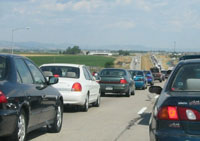People driving into USA from Mexico and Canada spend hours in lenghty lines
New inspection rules at the Canadian and Mexican borders have led to lengthy lines of cars nearly as long as they were after 9/11 terrorist attacks.

The longer lines of people driving into the United States from Mexico or Canada - some returning U.S. citizens - have appeared over the past month or two at several ports of entry.
The wait to cross became so long this month at Blue Water Bridge, which connects Port Huron, Michigan with Point Edward/Sarnia, Ontario, that the Ministry of Transportation in Ontario set up portable toilets along the road.
"Many motorists have become stranded in the lineups, not expecting such a long delay. Not since 9/11 have the backups been so common," said Garry McDonald, president of the Sarnia Lambton Chamber of Commerce, which requested the toilets.
Border residents and businesses blame new rules that require U.S. citizens to show driver's licenses, passports or other photo ID. They say there is not enough staff to inspect the documents, collect information and do additional vehicle checks.
At the Peace Bridge connecting Buffalo, New York, and Fort Erie, Ontario, time to inspect a vehicle rose from 54 seconds last year to about 75 seconds this year, said Ron Rienas, Peace Bridge general manager. People wanting to travel to Buffalo to shop or dine are deterred by the long lines, he said.
"Obviously something happened, some sort of policy directive that has resulted in longer processing times," Rienas said. "We've inquired, but the response we've gotten is, 'We've always done these kinds of checks."'
Previously, U.S. citizens could declare their citizenship, declare any goods they were bringing back with them and be waved through unless the inspector felt the need to do further checks.
At the Detroit Windsor Tunnel, average total crossing times have also increased. In January, it took 15 minutes to cross into the United States at the tunnel. So far in August, the average monthly time has been 23 minutes, said Neal Blitsky, president and general manager of Detroit Windsor Tunnel LLC, the tunnel's private operator.
In late July, hours-long waits were reported to reach a U.S. border station in Derby Line, Vermont, while there was no backup to cross into Canada.
Veronica Callaghan, who runs an industrial real estate business in El Paso, Texas, said many of the border community's residents are accustomed to seeing lines grow, but in the past three to four weeks, the waits have seemed longer as more ID checks are made.
The United States plans to require all citizens to show a passport or other photo ID deemed acceptable by the Homeland Security Department when they re-enter this country beginning January 30, 2008.
The plan is similar to passport requirements in effect now at airports as part of the Western Hemisphere Travel Initiative.
The tougher inspections follow a comment last month from Homeland Security Secretary Michael Chertoff that he had a "gut feeling" the nation faced an increased risk of attack this summer. In May, an inspector waved a tuberculosis-infected man through the Champlain, New York border station, despite a computer alert that he be stopped.
The long waits have heightened concerns that the inspections will choke off commerce.
Few on the border disagree on the need for stepped-up security, but they've been frustrated by the Homeland Security Department's clumsy attempts at it, said Maria Luisa O'Connell, president of the Border Trade Alliance, a U.S. association of border businesses, chambers of commerce, academic institutions and others.
O'Connell asked what good comes of checking licenses if even Chertoff acknowledges they are not secure documents. Some of the Sept. 11 terrorists had obtained one or more driver's licenses.
"We don't understand what the objective is," O'Connell said.
Subscribe to Pravda.Ru Telegram channel, Facebook, RSS!


